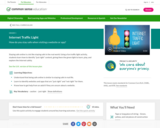
Teach language, vocabulary and listening comprehension with Celebrity Vocab clips! [1:22]
- Subject:
- Arts
- English Language Arts
- Material Type:
- Audio/Video
- Provider:
- PBS LearningMedia
- Date Added:
- 12/01/2022

Teach language, vocabulary and listening comprehension with Celebrity Vocab clips! [1:22]

Teach language, vocabulary and listening comprehension with Celebrity Vocab clips! [1:42]

Learn about how babies communicate their feelings and needs. Includes audio narration in 13 additional languages with text in English.

How do I convince others to understand my side of the story? Second grade students conducted shared research activities and participated in a Socratic Seminar practicing the techniques of persuasive reasoning.

It is very important to build a class community where all students feel valued and safe. This activity will do just that and you will address the Common Core speaking and listening standards. Students will get to know each by discussing what they've brought in their "Getting to Know You Bag". A letter template and video of the lesson in action are included.

Roll cubes to make answering questions. It's an exciting and engaging lesson.

In this lesson, the teacher will lead the class in a discussion about the value of role models and mentors. Remind the students to refer to their Career Day app assessment results, interview results, and resources. This is lesson four of five, which is designed to be taught in a sequence.
Estimated time required: 1-2 class periods.
Technology required for this lesson: Augmented Reality, Smartphone.

Teach language, vocabulary and listening comprehension with Celebrity Vocab clips! [2:23]

Teach language, vocabulary and listening comprehension with Celebrity Vocab clips! [1:11]

Teach language, vocabulary and listening comprehension with Celebrity Vocab clips! [1:56]

Through a shared reading of the familiar text, "The Gingerbread Man," students can learn to sound out familiar words. You will find step-by-step instructions as well as supplemental materials.

Teach language, vocabulary and listening comprehension with Celebrity Vocab clips! [2:13]

This video, effective for engaging students with significant cognitive disabilities, demonstrates how to identify how the character feels in a story.

Why is it important to listen to your feelings when using technology? This foundational digital citizenship lesson challenges kids to pay attention to their feelings while using tech. With an engaging emoji game, students learn practical strategies for managing their feelings -- good, bad, and everything in between. Approximately 30 mins.
LESSON OBJECTIVES: Recognize the different kinds of feelings they can have when using technology. Know what to do when they don't have a good feeling when using technology.

Teach language, vocabulary and listening comprehension with Celebrity Vocab clips! [3:17]

How do you stay safe when visiting a website or app? Staying safe online is a lot like staying safe in the real world. Using a fun traffic light activity, students learn how to identify "just right" content, giving them the green light to learn, play, and explore the internet safely. Approximately 35 mins.
LESSON OBJECTIVES: Understand that being safe online is similar to staying safe in real life. Learn to identify websites and apps that are "just right" and "not right" for them. Know how to get help from an adult if they are unsure about a website.

Teach language, vocabulary and listening comprehension with Celebrity Vocab clips! [2:28]

How can we be safe, responsible, and respectful online? From our head down to our toes, and our feet up to our nose, the Digital Citizens teach students how to be safe, responsible, and respectful online. Approximately 25 mins.
LESSON OBJECTIVES: Understand the importance of being safe, responsible, and respectful online. Learn the "Pause & Think Online" song to remember basic digital citizenship concepts.

In this video, effective for engaging students with significant cognitive disabilities, students are asked to identify the story elements, specifically the problem in the story.

This video, effective for engaging students with significant cognitive disabilities, demonstrates how to set a purpose then listen to see if you can find the solution.